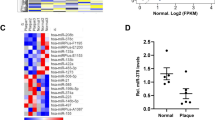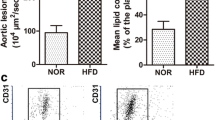Abstract
Purpose
Atherosclerosis is a narrowing of the arteries caused by plaque buildup. MicroRNAs (miRNAs) have been proposed to participate in the pathogenesis of atherosclerosis. Here, we aimed to investigate miR-205-5p’s role in promoting atherosclerotic progression.
Methods
Knock-in (KI) mice with human/murine miR-205-5p within the murine host gene for miR-205 (MIR205HG) were crossed with apolipoprotein E knockout (Apoe−/−) mice. This miR-205KI Apoe−/− murine model was employed to study the impact of miR-205-5p in Apoe−/− mice susceptible to atherosclerotic plaque formation.
Results
miR-205KI Apoe−/−mice developed larger, more unstable plaques relative to their Apoe−/− counterparts (0.45 vs. 0.26 mm2, P < 0.001). miR-205KI Apoe−/− mice exhibited lower serum levels of high-density lipoprotein cholesterol (HDL-C) (5.18 vs. 19.31 mg/dL, P < 0.001) and triglycerides (32.79 vs. 156.76 mg/dL, P < 0.001) with system-wide reversal of cholesterol transport. Macrophages derived from miR-205KI Apoe−/− mice exhibited ~ 20% lowered cholesterol efflux capability with enhanced pro-inflammatory gene expression through lipid raft formation. Bone marrow transplantation demonstrated that bone marrow (BM) donor cells with miR-205-5pKI simulated plaque formation independent of the recipients’ miR-205-5p status.
Conclusions
miR-205-5p encourages unstable atherogenesis in vivo. miR-205-5p also adversely influences lipid metabolism and promotes a pro-inflammatory macrophage phenotype. Our findings advocate miR-205-5p as a potential therapeutic target for combating unstable atherogenesis.





Similar content being viewed by others
References
Libby P, Ridker PM, Hansson GK. Progress and challenges in translating the biology of atherosclerosis. Nature. 2011;473(7347):317–25.
Feinberg MW, Moore KJ. MicroRNA regulation of atherosclerosis. Circ Res. 2016;118(4):703–20.
He L, Hannon GJ. MicroRNAs: small RNAs with a big role in gene regulation. Nat Rev Genet. 2004;5(7):522–31.
Kim CW, Kumar S, Son DJ, Jang I-H, Griendling KK, Jo H. Prevention of abdominal aortic aneurysm by anti–microRNA-712 or anti–microRNA-205 in angiotensin II–infused mice. Arterioscler Thromb Vasc Biol. 2014;34(7):1412–21.
Son DJ, Kumar S, Takabe W, Kim CW, Ni C-W, Alberts-Grill N, et al. The atypical mechanosensitive microRNA-712 derived from pre-ribosomal RNA induces endothelial inflammation and atherosclerosis. Nat Commun. 2013;4:3000.
Song H, Bu G. MicroRNA-205 inhibits tumor cell migration through down-regulating the expression of the LDL receptor-related protein 1. Biochem Biophys Res Commun. 2009;388(2):400–5.
Wild J, Stather P, Sylvius N, Choke E, Sayers R, Bown M. Low density lipoprotein receptor related protein 1 and abdominal aortic aneurysms. Eur J Vasc Endovasc Surg. 2012;44(2):127–32.
van Oers NS, Du Q, Dozmorov I, Raj P, Molina E, de la Morena MT, et al. MIR205HG is a long noncoding RNA with distinct functions in the Thymus versus the anterior pituitary. Am Assoc Immnol. 2018.165–11.
Du Q, Hoover AR, Dozmorov I, Raj P, Khan S, Molina E, et al. MIR205HG is a long noncoding RNA that regulates growth hormone and prolactin production in the anterior pituitary. Dev Cell. 2019;49(4):618–31 e5.
Mi H, Huang X, Muruganujan A, Tang H, Mills C, Kang D, et al. PANTHER version 11: expanded annotation data from gene ontology and reactome pathways, and data analysis tool enhancements. Nucleic Acids Res. 2017;45:D1.
Zhang Y, Buchholz F, Muyrers JP, Stewart AF. A new logic for DNA engineering using recombination in Escherichia coli. Nat Genet. 1998;20(2):123–8.
Datta S, Costantino N, Court DL. A set of recombineering plasmids for gram-negative bacteria. Gene. 2006;379:109–15.
Nagy A, Rossant J, Nagy R, Abramow-Newerly W, Roder JC. Derivation of completely cell culture-derived mice from early-passage embryonic stem cells. Proc Natl Acad Sci. 1993;90(18):8424–8.
Morita M, Ohneda O, Yamashita T, Takahashi S, Suzuki N, Nakajima O, et al. HLF/HIF-2α is a key factor in retinopathy of prematurity in association with erythropoietin. EMBO J. 2003;22(5):1134–46.
Tangirala RK, Rubin EM, Palinski W. Quantitation of atherosclerosis in murine models: correlation between lesions in the aortic origin and in the entire aorta, and differences in the extent of lesions between sexes in LDL receptor-deficient and apolipoprotein E-deficient mice. J Lipid Res. 1995;36(11):2320–8.
Paigen B, Morrow A, Holmes PA, Mitchell D, Williams RA. Quantitative assessment of atherosclerotic lesions in mice. Atherosclerosis. 1987;68(3):231–40.
Daugherty A, Tall AR, Daemen MJ, Falk E, Fisher EA, García-Cardeña G, et al. Recommendation on design, execution, and reporting of animal atherosclerosis studies: a scientific statement from the American Heart Association. Circ Res. 2017;121(6):e53–79.
Horie T, Ono K, Nishi H, Nagao K, Kinoshita M, Watanabe S, et al. Acute doxorubicin cardiotoxicity is associated with miR-146a-induced inhibition of the neuregulin-ErbB pathway. Cardiovasc Res. 2010;87(4):656–64.
Toshima G, Iwama Y, Kimura F, Matsumoto Y, Miura M, Takahashi J, et al. LipoSEARCH®; analytical GP-HPLC method for lipoprotein profiling and its applications. J Biol Macromol. 2013;13(2):21–32.
Okazaki M, Yamashita S. Recent advances in analytical methods on lipoprotein subclasses: calculation of particle numbers from lipid levels by gel permeation HPLC using “spherical particle model”. J Oleo Sci. 2016;65(4):265–82.
de la Llera-Moya M, Drazul-Schrader D, Asztalos BF, Cuchel M, Rader DJ, Rothblat GH. The ability to promote efflux via ABCA1 determines the capacity of serum specimens with similar high-density lipoprotein cholesterol to remove cholesterol from macrophages. Arterioscler Thromb Vasc Biol. 2010;30(4):796–801.
Horie T, Ono K, Horiguchi M, Nishi H, Nakamura T, Nagao K, et al. MicroRNA-33 encoded by an intron of sterol regulatory element-binding protein 2 (Srebp2) regulates HDL in vivo. Proc Natl Acad Sci. 2010;107(40):17321–6.
Yvan-Charvet L, Ranalletta M, Wang N, Han S, Terasaka N, Li R, et al. Combined deficiency of ABCA1 and ABCG1 promotes foam cell accumulation and accelerates atherosclerosis in mice. J Clin Invest. 2007;117(12):3900–8.
Yao PM, Tabas I. Free cholesterol loading of macrophages is associated with widespread mitochondrial dysfunction and activation of the mitochondrial apoptosis pathway. J Biol Chem. 2001;276(45):42468–76.
Horie T, Baba O, Kuwabara Y, Chujo Y, Watanabe S, Kinoshita M, et al. Micro RNA-33 deficiency reduces the progression of atherosclerotic plaque in ApoE−/− mice. J Am Heart Assoc. 2012;1(6):e003376.
Van Eck M, Singaraja RR, Ye D, Hildebrand RB, James ER, Hayden MR, et al. Macrophage ATP-binding cassette transporter A1 overexpression inhibits atherosclerotic lesion progression in low-density lipoprotein receptor knockout mice. Arterioscler Thromb Vasc Biol. 2006;26(4):929–34.
Aparicio-Vergara M, Shiri-Sverdlov R, de Haan G, Hofker MH. Bone marrow transplantation in mice as a tool for studying the role of hematopoietic cells in metabolic and cardiovascular diseases. Atherosclerosis. 2010;213(2):335–44.
Horie T, Nishino T, Baba O, Kuwabara Y, Nakao T, Nishiga M, et al. MicroRNA-33 regulates sterol regulatory element-binding protein 1 expression in mice. Nat Commun. 2013;4:2883.
Grundy SM. Scavenger receptor B-1 emerges as anti-atherogenic candidate. Cell Metab. 2016;23(5):755–7.
Williams KJ. Molecular processes that handle—and mishandle—dietary lipids. J Clin Invest. 2008;118(10):3247–59.
Bauer RC, Khetarpal SA, Hand NJ, Rader DJ. Therapeutic targets of triglyceride metabolism as informed by human genetics. Trends Mol Med. 2016;22(4):328–40.
Chistiakov DA, Bobryshev YV, Orekhov AN. Macrophage-mediated cholesterol handling in atherosclerosis. J Cell Mol Med. 2016;20(1):17–28.
Weber C, Noels H. Atherosclerosis: current pathogenesis and therapeutic options. Nat Med. 2011;17(11):1410–22.
Cui M, Wang Y, Sun B, Xiao Z, Ye L, Zhang X. MiR-205 modulates abnormal lipid metabolism of hepatoma cells via targeting acyl-CoA synthetase long-chain family member 1 (ACSL1) mRNA. Biochem Biophys Res Commun. 2014;444(2):270–5.
Flowers E, Singh K, Molina C, Mathur A, Aouizerat BE. MicroRNA associated with atherogenic dyslipidemia in South Asian men. Int J Cardiol. 2013;168(5).214–332.
Nishino T, Horie T, Kuwabara Y, Nakao T, Nishiga M, Ide Y, et al. Microrna-33b promotes atherosclerotic plaque formation in Apoe-/- mice. Circulation. 2017;136(suppl_1):A17676-A.
Brophy ML, Dong Y, Tao H, Yancey PG, Song K, Zhang K, et al. Myeloid-specific deletion of Epsins 1 and 2 reduces atherosclerosis by preventing LRP-1 downregulation. Circ Res. 2019;124(4):e6–e19.
Oldoni F, van Capelleveen JC, Dalila N, Wolters JC, Heeren J, Sinke RJ, et al. Naturally occurring variants in LRP1 (low-density lipoprotein receptor–related protein 1) affect HDL (high-density lipoprotein) metabolism through ABCA1 (ATP-binding cassette A1) and SR-B1 (scavenger receptor class B type 1) in humans. Arterioscler Thromb Vasc Biol. 2018;38(7):1440–53.
Navab M, Reddy ST, Van Lenten BJ, Anantharamaiah G, Fogelman AM. The role of dysfunctional HDL in atherosclerosis. J Lipid Res. 2009;50(Supplement):S145–S9.
Mora S, Szklo M, Otvos JD, Greenland P, Psaty BM, Goff DC Jr, et al. LDL particle subclasses, LDL particle size, and carotid atherosclerosis in the multi-ethnic study of atherosclerosis (MESA). Atherosclerosis. 2007;192(1):211–7.
Ye D, Lammers B, Zhao Y, Meurs I, Van Berkel TJC, Van Eck M. ATP-binding cassette transporters A1 and G1, HDL metabolism, cholesterol efflux, and inflammation: important targets for the treatment of atherosclerosis. Curr Drug Targets. 2011;12(5):647–60.
Moore KJ, Sheedy FJ, Fisher EA. Macrophages in atherosclerosis: a dynamic balance. Nat Rev Immunol. 2013;13(10):709–21.
Randolph GJ. Mechanisms that regulate macrophage burden in atherosclerosis. Circ Res. 2014;114(11):1757–71.
Tall AR, Yvan-Charvet L, Terasaka N, Pagler T, Wang N. HDL, ABC transporters, and cholesterol efflux: implications for the treatment of atherosclerosis. Cell Metab. 2008;7(5):365–75.
Zhu X, Owen JS, Wilson MD, Li H, Griffiths GL, Thomas MJ, et al. Macrophage ABCA1 reduces MyD88-dependent toll-like receptor trafficking to lipid rafts by reduction of lipid raft cholesterol. J Lipid Res. 2010;51(11):3196–206.
Xian X, Ding Y, Dieckmann M, Zhou L, Plattner F, Liu M, et al. LRP1 integrates murine macrophage cholesterol homeostasis and inflammatory responses in atherosclerosis. Elife. 2017;6:e29292.
Neele AE, Gijbels MJ, van der Velden S, Hoeksema MA, Boshuizen MC, Prange KH, et al. Myeloid Kdm6b deficiency results in advanced atherosclerosis. Atherosclerosis. 2018;275:156–65.
Zhao L, Cozzo AJ, Johnson AR, Christensen T, Freemerman AJ, Bear JE, et al. Lack of myeloid Fatp1 increases atherosclerotic lesion size in Ldlr−/− mice. Atherosclerosis. 2017;266:182–9.
Mathur P, Ostadal B, Romeo F, Mehta JL. Gender-related differences in atherosclerosis. Cardiovasc Drugs Ther. 2015;29(4):319–27.
Kallen AN, Pal L. Cardiovascular disease and ovarian function. Curr Opin Obstet Gynecol. 2011;23(4):258–67.
Cochain C, Zernecke A. Macrophages and immune cells in atherosclerosis: recent advances and novel concepts. Basic Res Cardiol. 2015;110(4):34.
Author information
Authors and Affiliations
Contributions
Conceived and designed the study: XDM
Performed the experimental procedures: XDM, JJY, XLY, and YGG
Analyzed the data: JJY and YGG
Drafted the manuscript: XDM
Corresponding author
Ethics declarations
Conflict of Interest
The authors declare that they have no conflict of interest.
Ethical Approval
All applicable international, national, and/or institutional guidelines for the care and use of animals were followed.
Informed Consent
Informed consent was obtained from all individual participants included in the study.
Additional information
Publisher’s Note
Springer Nature remains neutral with regard to jurisdictional claims in published maps and institutional affiliations.
Electronic supplementary material
ESM 1
(DOC 3194 kb).
Rights and permissions
About this article
Cite this article
Meng, X., Yin, J., Yu, X. et al. MicroRNA-205-5p Promotes Unstable Atherosclerotic Plaque Formation In Vivo. Cardiovasc Drugs Ther 34, 25–39 (2020). https://doi.org/10.1007/s10557-020-06935-9
Published:
Issue Date:
DOI: https://doi.org/10.1007/s10557-020-06935-9




